Perovskite Nanoparticles as an Electrochemical Sensing Platform for Detection of Warfarin
Abstract
:1. Introduction
2. Experimental
2.1. Materials
2.2. Synthesis of PrAlO3 Perovskite NPs
2.3. Characterization
3. Results and Discussion
3.1. Crystallographic and Morphological Structure
3.2. Thermal Analysis
3.3. Optical Properties
3.4. Electrochemical Characterization
3.5. Electrochemical Sensing Properties
3.6. Electrochemical Stability and Reproducibility
3.7. Impact of Time Response with Perovskite/GCE against Warfarin
3.8. Real Sample Analysis
4. Conclusions
Author Contributions
Funding
Institutional Review Board Statement
Informed Consent Statement
Data Availability Statement
Acknowledgments
Conflicts of Interest
References
- Comby, S.; Gunnlaugsson, T. Luminescent Lanthanide-Functionalized Gold Nanoparticles: Exploiting the Interaction with Bovine Serum Albumin for Potential Sensing Applications. ACS Nano 2011, 5, 7184–7197. [Google Scholar] [CrossRef] [PubMed]
- Patra, A.K.; Mukhopadhyay, R.; Mukhija, R.; Krishnan, A.; Garg, L.C.; Panda, A.K. Optimization of inclusion body solubilization and renaturation of recombinant human growth hormone from Escherichia coli. Protein Expr. Purif. 2000, 18, 182–192. [Google Scholar] [CrossRef] [PubMed]
- Sanyal, U.; Bhattacharyya, S.; Patra, A.; Hazra, B. Liquid chromatographic separation of derivatives of diospyrin, a bioactive bisnaphthoquinonoid plant-product, and analogous naphthyl compounds. J. Chromatogr. A 2003, 1017, 225–232. [Google Scholar] [CrossRef] [PubMed]
- Hu, G.S.; Sheng, W.; Zhang, Y.; Wu, X.N.; Wang, S. A novel and sensitive fluorescence immunoassay for the detection of fluoroquinolones in animal-derived foods using upconversion nanoparticles as labels. Anal. Bioanal. Chem. 2015, 407, 8487–8496. [Google Scholar] [CrossRef]
- Zhang, S.W.; Yao, T.Q.; Wang, S.F.; Feng, R.H.; Chen, L.Q.; Zhu, V.; Hu, G.P.; Zhang, H.; Yang, G.W. Development of an Upconversion Luminescence Nanoparticles-Based Immunochromatographic Assay for the Rapid Detection of Dexamethasone in Animal Tissue. Food Anal. Methods 2019, 12, 752–760. [Google Scholar] [CrossRef]
- Peng, Q.; Shan, B.; Wen, Y.W.; Chen, R. Enhanced charge transport of LaFeO3 via transition metal (Mn, Co, Cu) doping for visible light photoelectrochemical water oxidation. Int. J. Hydrog. Energy 2015, 40, 15423–15431. [Google Scholar] [CrossRef]
- Kumar, R.A.; Dutta, A.; Mukhopadhyay, P.K.; Sinha, T.P. Antiferromagnetic behaviour and dielectric relaxation of xBa(2)FeNbO(6)-(1-x) LaFeO3(x = 0.1, 0.3, 0.5). J. Alloys Compd. 2018, 730, 201–207. [Google Scholar] [CrossRef]
- Jin, Y.; Zhang, J.H.; Lu, S.Z.; Zhao, H.F.; Zhang, X.; Wang, X.J. Fabrication of Eu3+ and SM3+ codoped micro/nanosized MMoO4 (M = Ca, Ba, and Sr) via facile hydrothermal method and their photoluminescence properties through energy transfer. J. Phys. Chem. C 2008, 112, 5860–5864. [Google Scholar] [CrossRef]
- Ansari, A.A.; Labis, J.P. Preparation and photoluminescence properties of hydrothermally synthesized YVO4:Eu3+ nanofibers. Mater. Lett. 2012, 88, 152–155. [Google Scholar] [CrossRef]
- Ansari, A.A.; Parchur, A.K.; Alam, M.; Azzeer, A. Effect of surface coating on optical properties of Eu3+-doped CaMoO4 nanoparticles. Spectrochim. Acta Part A-Mol. Biomol. Spectrosc. 2014, 131, 30–36. [Google Scholar] [CrossRef]
- Mahalingam, V.; Thirumalai, J.; Krishnan, R.; Chandramohan, R. Potential visible light emitting rare-earth activated Ca0.5Y1-x(MoO4)(2):xRE(3+) (RE = Pr, Sm, Eu, Tb, Dy) phosphors for solid state lighting applications. J. Mater. Sci.-Mater. Electron. 2015, 26, 842–852. [Google Scholar] [CrossRef]
- Ansari, A.A.; Alam, M. Optical and structural studies of CaMoO4:Sm, CaMoO4:Sm@CaMoO4 and CaMoO4:Sm@CaMoO4@SiO2 core-shell nanoparticles. J. Lumin. 2015, 157, 257–263. [Google Scholar] [CrossRef]
- Ansari, A.A. Photochemical studies of monodispersed YPO4:Eu microspheres: The role of surface modification on structural and luminescence properties. J. Photochem. Photobiol. A-Chem. 2017, 343, 126–132. [Google Scholar] [CrossRef]
- Ansari, A.A. Effect of surface coating on structural and photophysical properties of CePO4:Tb, nanorods. Mater. Sci. Eng. B-Adv. Funct. Solid-State Mater. 2017, 222, 43–48. [Google Scholar] [CrossRef]
- Ansari, A.A. Silica-modified luminescent LaPO4:Eu@LaPO4@SiO2 core/shell nanorods: Synthesis, structural and luminescent properties. Luminescence 2018, 33, 112–118. [Google Scholar] [CrossRef] [PubMed]
- Ansari, A.A.; Sillanpää, M. Advancement in upconversion nanoparticles based NIR-driven photocatalysts. Renew. Sustain. Energy Rev. 2021, 151, 111631. [Google Scholar] [CrossRef]
- Ansari, A.A.; Malhotra, B.D. Current progress in organic–inorganic hetero-nano-interfaces based electrochemical biosensors for healthcare monitoring. Coord. Chem. Rev. 2022, 452, 214282. [Google Scholar] [CrossRef]
- Ansari, A.A.; Ahmad, N.; Alam, M.; Adil, S.F.; Ramay, S.M.; Albadri, A.; Ahmad, A.; Al-Enizi, A.M.; Alrayes, B.F.; Assal, M.E.; et al. Physico-chemical properties and catalytic activity of the sol-gel prepared Ce-ion doped LaMnO3 perovskites. Sci. Rep. 2019, 9, 7747. [Google Scholar] [CrossRef]
- Ansari, A.A.; Ahmad, N.; Alam, M.; Adil, S.F.; Assal, M.E.; Albadri, A.; Al-Enizi, A.M.; Khan, M. Optimization of Redox and Catalytic Performance of LaFeO3 Perovskites: Synthesis and Physicochemical Properties. J. Electron. Mater. 2019, 48, 4351–4361. [Google Scholar] [CrossRef]
- Ansari, A.A.; Adil, S.F.; Alam, M.; Ahmad, N.; Assal, M.E.; Labis, J.P.; Alwarthan, A. Catalytic performance of the Ce-doped LaCoO3 perovskite nanoparticles. Sci. Rep. 2020, 10, 15012. [Google Scholar] [CrossRef]
- Zhao, C.Y.; Feng, S.H.; Chao, Z.C.; Shi, C.S.; Xu, R.; Ni, J.Z. Hydrothermal synthesis of the complex fluorides LiBaF3 and KMgF3 with perovskite structures under mild conditions. Chem. Commun. 1996, 14, 1641–1642. [Google Scholar] [CrossRef]
- Cheng, G.; Tan, X.F.; Song, X.J.; Chen, X.; Dai, W.X.; Yuan, R.S.; Fu, X.Z. Visible light assisted thermocatalytic reaction of CO plus NO over Pd/LaFeO3. Appl. Catal. B-Environ. 2019, 251, 130–142. [Google Scholar] [CrossRef]
- Lee, Y.E.; Chung, W.C.; Chang, M.B. Photocatalytic oxidation of toluene and isopropanol by LaFeO3/black-TiO2. Environ. Sci. Pollut. Res. 2019, 26, 20908–20919. [Google Scholar] [CrossRef] [PubMed]
- Rong, Q.; Zhang, Y.M.; Li, K.J.; Wang, H.P.; Hu, J.C.; Zhu, Z.Q.; Zhang, J.; Liu, Q.J. Ag-LaFeO3/NCQDs p-n heterojunctions for superior methanol gas sensing performance. Mater. Res. Bull. 2019, 115, 55–64. [Google Scholar] [CrossRef]
- Xiao, P.; Zhu, J.J.; Zhao, D.; Zhao, Z.; Zaera, F.; Zhu, Y.J. Porous LaFeO3 Prepared by an in Situ Carbon Templating Method for Catalytic Transfer Hydrogenation Reactions. ACS Appl. Mater. Interfaces 2019, 11, 15517–15527. [Google Scholar] [CrossRef] [PubMed]
- Fang, L.; Ding, X.L.; Song, Y.; Liu, D.M.; Li, Y.T.; Zhang, Q.A. Effect of Morphological Tuning on Electrochemical Performance of Perovskite LaCoO3 Anodes. Chem. J. Chin. Univ.-Chin. 2019, 40, 1456–1463. [Google Scholar] [CrossRef]
- Arman, M.M.; Ahmed, M.A.; El-Dek, S.I. Influence of vacancy co-doping on the physical features of NdFeO3 nanostructure perovskites. Appl. Phys. A-Mater. Sci. Process. 2020, 126, 27. [Google Scholar] [CrossRef]
- Qi, F.; Xiao, Y.; Yu, Z.; Liu, P.; Kong, S.; Li, F.; Zhang, H.; Wang, Y.; Zhao, X.-Z. Performance enhancement of hole-transport material free perovskite solar cells with TiO2 nanorods modified with SiO2/NaYF4:Yb,Er@SiO2 for upconversion and charge recombination suppression. Org. Electron. 2019, 73, 152–158. [Google Scholar] [CrossRef]
- Bi, W.; Wu, Y.; Chen, C.; Zhou, D.; Song, Z.; Li, D.; Chen, G.; Dai, Q.; Zhu, Y.; Song, H. Dye Sensitization and Local Surface Plasmon Resonance-Enhanced Upconversion Luminescence for Efficient Perovskite Solar Cells. ACS Appl. Mater. Interfaces 2020, 12, 24737–24746. [Google Scholar] [CrossRef]
- Nassar, I.M.; Wu, S.L.; Li, L.; Li, X.F. Facile Preparation of n-Type LaFeO3 Perovskite Film for Efficient Photoelectrochemical Water Splitting. Chemistryselect 2018, 3, 968–972. [Google Scholar] [CrossRef]
- Pawar, G.S.; Elikkottil, A.; Pesala, B.; Tahir, A.A.; Mallick, T.K. Plasmonic nickel nanoparticles decorated on to LaFeO3 photocathode for enhanced solar hydrogen generation. Int. J. Hydrog. Energy 2019, 44, 578–586. [Google Scholar] [CrossRef]
- Enache, S.; Dragan, M.; Varlam, M.; Petrov, K. Electronic Percolation Threshold of Self-Standing Ag-LaCoO3 Porous Electrodes for Practical Applications. Materials 2019, 12, 2359. [Google Scholar] [CrossRef] [Green Version]
- Shafi, P.M.; Ganesh, V.; Bose, A.C. LaMnO3/RGO/PANI Ternary Nanocomposites for Supercapacitor Electrode Application and Their Outstanding Performance in All-Solid-State Asymmetrical Device Design. ACS Appl. Energy Mater. 2018, 1, 2802–2812. [Google Scholar] [CrossRef]
- Harikrishnan, M.P.; Bose, A.C. Perovskite Oxide LaCoO3 Electrode as High Performance Pseudocapacitor. In Proceedings of the 3rd International Conference on Optoelectronic and Nano Materials for Advanced Technology (Iconmat 2019), Kerala, India, 3–5 January 2019. [Google Scholar] [CrossRef]
- Song, Y.L.; Wang, Z.C.; Yan, Y.D.; Zhang, M.L.; Wang, G.L.; Yin, T.Q.; Xue, Y.; Gao, F.; Qiu, M. Molten salt synthesis and supercapacitor properties of oxygen-vacancy LaMnO3-delta. J. Energy Chem. 2020, 43, 173–181. [Google Scholar] [CrossRef] [Green Version]
- Guo, J.F.; Li, P.T.; Yang, Z. A novel Z-scheme g- C3N4/LaCoO3 heterojunction with enhanced photocatalytic activity in degradation of tetracycline hydrochloride. Catal. Commun. 2019, 122, 63–67. [Google Scholar] [CrossRef]
- Wang, Z.; Liu, J.; Yang, Y.J.; Yu, Y.N.; Yan, X.C.; Zhang, Z. Insights into the catalytic behavior of LaMnO3 perovskite for Hg-0 oxidation by HCl. J. Hazard. Mater. 2020, 383, 121156. [Google Scholar] [CrossRef] [PubMed]
- Wang, X.T.; Li, Y.; Zhang, X.Q.; Li, J.F.; Li, X.; Wang, C.W. Design and fabrication of NiS/LaFeO3 heterostructures for high efficient photodegradation of organic dyes. Appl. Surf. Sci. 2020, 504, 144363. [Google Scholar] [CrossRef]
- Pawar, G.S.; Elikkottil, A.; Seetha, S.; Reddy, K.S.; Pesala, B.; Tahir, A.A.; Mallick, T.K. Enhanced Photoactivity and Hydrogen Generation of LaFeO3 Photocathode by Plasmonic Silver Nanoparticle Incorporation. ACS Appl. Energy Mater. 2018, 1, 3449–3456. [Google Scholar] [CrossRef]
- Gong, C.; Zhang, Z.Y.; Lin, S.; Wu, Z.; Sun, L.; Ye, C.Q.; Hu, Y.L.; Lin, C.J. Electrochemical synthesis of perovskite LaFeO3 nanoparticle-modified TiO2 nanotube arrays for enhanced visible-light photocatalytic activity. New J. Chem. 2019, 43, 16506–16514. [Google Scholar] [CrossRef]
- Ansari, A.A.; Nazeeruddin, M.K.; Tavakoli, M.M. Organic-inorganic upconversion nanoparticles hybrid in dye-sensitized solar cells. Coord. Chem. Rev. 2021, 436, 213805. [Google Scholar] [CrossRef]
- Zhang, G.H.; Chen, Q.; Deng, X.Y.; Jiao, H.Y.; Wang, P.Y.; Gengzang, D.J. Synthesis and characterization of In-doped LaFeO3 hollow nanofibers with enhanced formaldehyde sensing properties. Mater. Lett. 2019, 236, 229–232. [Google Scholar] [CrossRef]
- Chumakova, V.; Marikutsa, A.; Rumyantseva, M.; Fasquelle, D.; Gaskov, A. Nanocrystalline LaCoO3 modified by Ag nanoparticles with improved sensitivity to H2S. Sens. Actuators B-Chem. 2019, 296, 126661. [Google Scholar] [CrossRef]
- Alharbi, A.A.; Sackmann, A.; Weimar, U.; Barsan, N. A highly selective sensor to acetylene and ethylene based on LaFeO3. Sens. Actuators B-Chem. 2020, 303, 127204. [Google Scholar] [CrossRef]
- Zhang, W.; Xie, C.S.; Zhang, G.Z.; Zhang, J.; Zhang, S.P.; Zeng, D.W. Porous LaFeO3/SnO2 nanocomposite film for CO2 detection with high sensitivity. Mater. Chem. Phys. 2017, 186, 228–236. [Google Scholar] [CrossRef]
- Wang, C.; Rong, Q.; Zhang, Y.M.; Zhu, Z.Q.; Zhang, J.; Liu, Q.J. Fabrication of Low Operating Temperature Acetone Sensor Based on Ag-LaFeO3 Nanomaterials. In Proceedings of the 2nd International Conference on Frontiers of Sensors Technologies (ICFST), Shenzhen, China, 14–16 April 2017; pp. 64–67. [Google Scholar]
- Zhang, Y.M.; Rong, Q.; Zhao, J.H.; Zhang, J.; Zhu, Z.Q.; Liu, Q.J. Boron-doped graphene quantum dot/Ag-LaFeO3 p-p heterojunctions for sensitive and selective benzene detection. J. Mater. Chem. A 2018, 6, 12647–12653. [Google Scholar] [CrossRef]
- Cao, E.S.; Chu, Z.W.; Wang, H.H.; Hao, W.T.; Sun, L.; Zhang, Y.J. Effect of film thickness on the electrical and ethanol sensing characteristics of LaFeO3 nanoparticle-based thick film sensors. Ceram. Int. 2018, 44, 7180–7185. [Google Scholar] [CrossRef]
- Wang, H.H.; Guo, Z.Q.; Hao, W.T.; Sun, L.; Zhang, Y.J.; Cao, E.S. Ethanol sensing characteristics of BaTiO3/LaFeO3 nanocomposite. Mater. Lett. 2019, 234, 40–44. [Google Scholar] [CrossRef]
- Wang, C.; Rong, Q.; Zhang, Y.M.; Hu, J.C.; Zi, B.Y.; Zhu, Z.Q.; Zhang, J.; Liu, Q.J. Molecular imprinting Ag-LaFeO3 spheres for highly sensitive acetone gas detection. Mater. Res. Bull. 2019, 109, 265–272. [Google Scholar] [CrossRef]
- Karuppiah, C.; Wei, C.-N.; Karikalan, N.; Wu, Z.-H.; Thirumalraj, B.; Hsu, L.-F.; Alagar, S.; Piraman, S.; Hung, T.-F.; Li, Y.-J.J.; et al. Graphene Nanosheet-Wrapped Mesoporous La0.8Ce0.2Fe0.5Mn0.5O3 Perovskite Oxide Composite for Improved Oxygen Reaction Electro-Kinetics and Li-O2 Battery Application. Nanomaterials 2021, 11, 1025. [Google Scholar] [CrossRef]
- Zhang, L.; Zhang, Y.; Wei, J.; Liu, W. Perovskite LaFexCo1-xO3-λ deposited SiO2 catalytic membrane for deeply cleaning wastewater. Chem. Eng. J. 2021, 403, 126386. [Google Scholar] [CrossRef]
- Mefford, J.T.; Hardin, W.G.; Dai, S.; Johnston, K.P.; Stevenson, K.J. Anion charge storage through oxygen intercalation in LaMnO3 perovskite pseudocapacitor electrodes. Nat. Mater. 2014, 13, 726–732. [Google Scholar] [CrossRef] [PubMed]
- Sasikala, C.; Durairaj, N.; Baskaran, I.; Sathyaseelan, B.; Henini, M.; Manikandan, E. Transition metal titanium (Ti) doped LaFeO3 nanoparticles for enhanced optical structural and magnetic properties. J. Alloys Compd. 2017, 712, 870–877. [Google Scholar] [CrossRef] [Green Version]
- Ansari, A.A.; Alam, M.; Parchur, A.K. Nd-doped calcium molybdate core and particles: Synthesis, optical and photoluminescence studies. Appl. Phys. A-Mater. Sci. Process. 2014, 116, 1719–1728. [Google Scholar] [CrossRef]
- Ansari, A.A.; Parchur, A.K.; Alam, M.; Labis, J.; Azzeer, A. Influence of Surface Coating on Structural and Photoluminescent Properties of CaMoO4:Pr Nanoparticles. J. Fluoresc. 2014, 24, 1253–1262. [Google Scholar] [CrossRef] [PubMed]
- Aldalbahi, A.; Rahaman, M.; Ansari, A.A. Mesoporous silica modified luminescent Gd2O3:Eu nanoparticles: Physicochemical and luminescence properties. J. Sol-Gel Sci. Technol. 2019, 89, 785–795. [Google Scholar] [CrossRef]
- Ansari, A.A.; Khan, A.; Labis, J.P.; Alam, M.; Aslam Manthrammel, M.; Ahamed, M.; Akhtar, M.J.; Aldalbahi, A.; Ghaithan, H. Mesoporous multi-silica layer-coated Y2O3:Eu core-shell nanoparticles: Synthesis, luminescent properties and cytotoxicity evaluation. Mater. Sci. Eng. C 2019, 96, 365–373. [Google Scholar] [CrossRef]
- Ansari, A.A.; Ahmad, N.; Labis, J.P.; El-Toni, A.M.; Khan, A. Aqueous dispersible green luminescent yttrium oxide:terbium microspheres with nanosilica shell coating. Spectrochim. Acta Part A Mol. Biomol. Spectrosc. 2019, 211, 348–355. [Google Scholar] [CrossRef]
- Ansari, A.A.; Labis, J.; Alam, M.; Ramay, S.M.; Ahmad, N.; Mahmood, A. Influence of copper ion doping on structural, optical and redox properties of CeO2 nanoparticles. J. Electroceram. 2016, 36, 150–157. [Google Scholar] [CrossRef]
- Ansari, A.A.; Labis, J.; Alam, M.; Ramay, S.M.; Ahmad, N.; Mahmood, A. Effect of cobalt doping on structural, optical and redox properties cerium oxide nanoparticles. Phase Transit. 2016, 89, 261–272. [Google Scholar] [CrossRef]
- Ansari, A.A.; Labis, J.P.; Alam, M.; Ramay, S.M.; Ahmad, N.; Mahmood, A. Synthesis, Structural and Optical Properties of Mn-Doped Ceria Nanoparticles: A Promising Catalytic Material. Acta Metall. Sin.-Engl. Lett. 2016, 29, 265–273. [Google Scholar] [CrossRef]
- Ansari, A.A.; Alam, M.; Ali, M.A. Nanostructured CeO2:Ag platform for electrochemically sensitive detection of nitrophenol. Colloids Surf. A Physicochem. Eng. Asp. 2021, 613, 126116. [Google Scholar] [CrossRef]
- Ansari, A.A.; Solanki, P.R.; Malhotra, B.D. Sol-gel derived nanostructured cerium oxide film for glucose sensor. Appl. Phys. Lett. 2008, 92, 263901. [Google Scholar] [CrossRef]
- Khan, R.; Kaushik, A.; Solanki, P.R.; Ansari, A.A.; Pandey, M.K.; Malhotra, B.D. Zinc oxide nanoparticles-chitosan composite film for cholesterol biosensor. Anal. Chim. Acta 2008, 616, 207–213. [Google Scholar] [CrossRef] [PubMed]
- Ansari, A.A.; Solanki, P.R.; Malhotra, B.D. Hydrogen peroxide sensor based on horseradish peroxidase immobilized nanostructured cerium oxide film. J. Biotechnol. 2009, 142, 179–184. [Google Scholar] [CrossRef] [PubMed]
- Ansari, A.A.; Kaushik, A.; Solanki, P.R.; Malhotra, B.D. Electrochemical Cholesterol Sensor Based on Tin Oxide-Chitosan Nanobiocomposite Film. Electroanalysis 2009, 21, 965–972. [Google Scholar] [CrossRef]

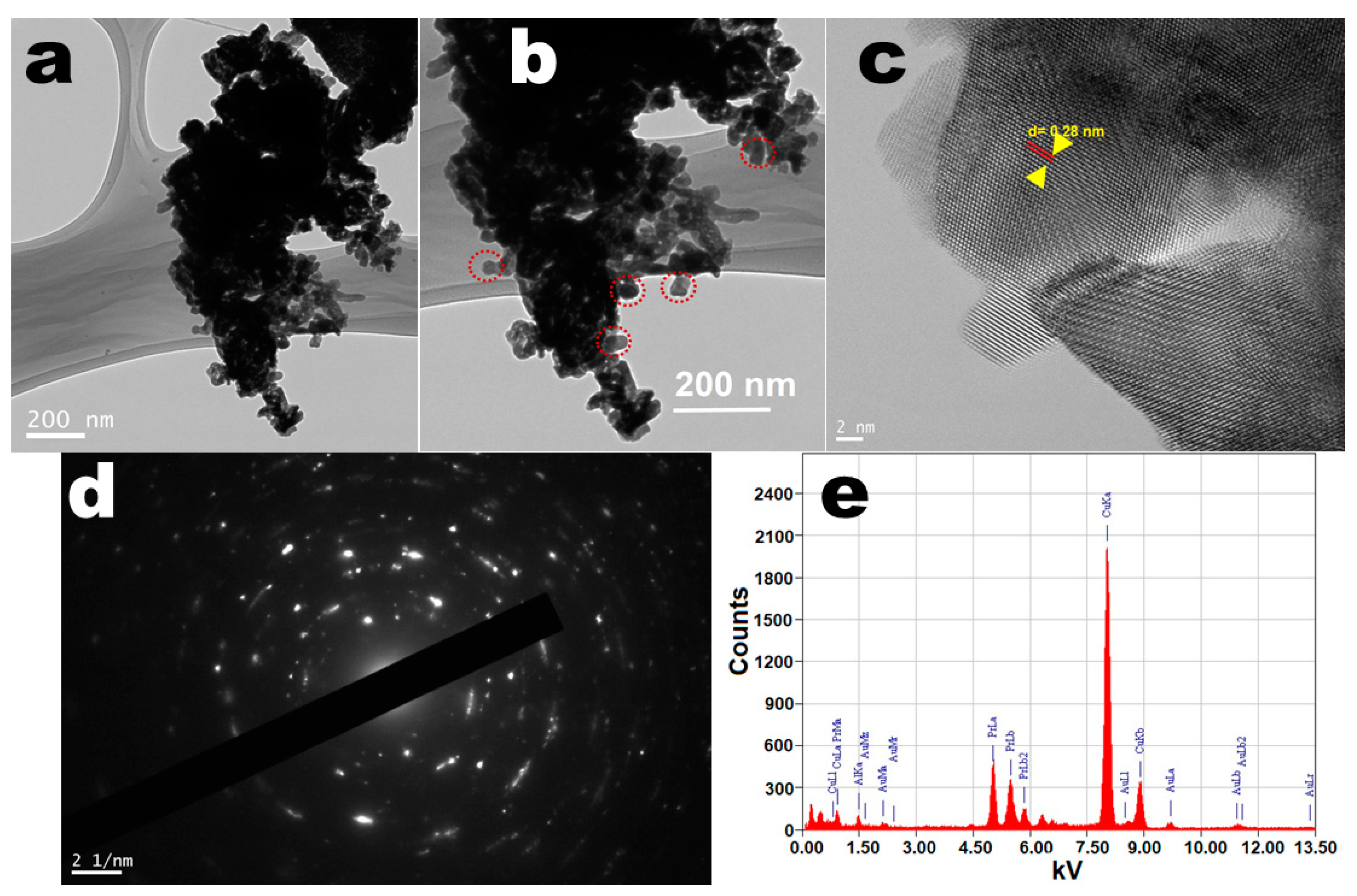
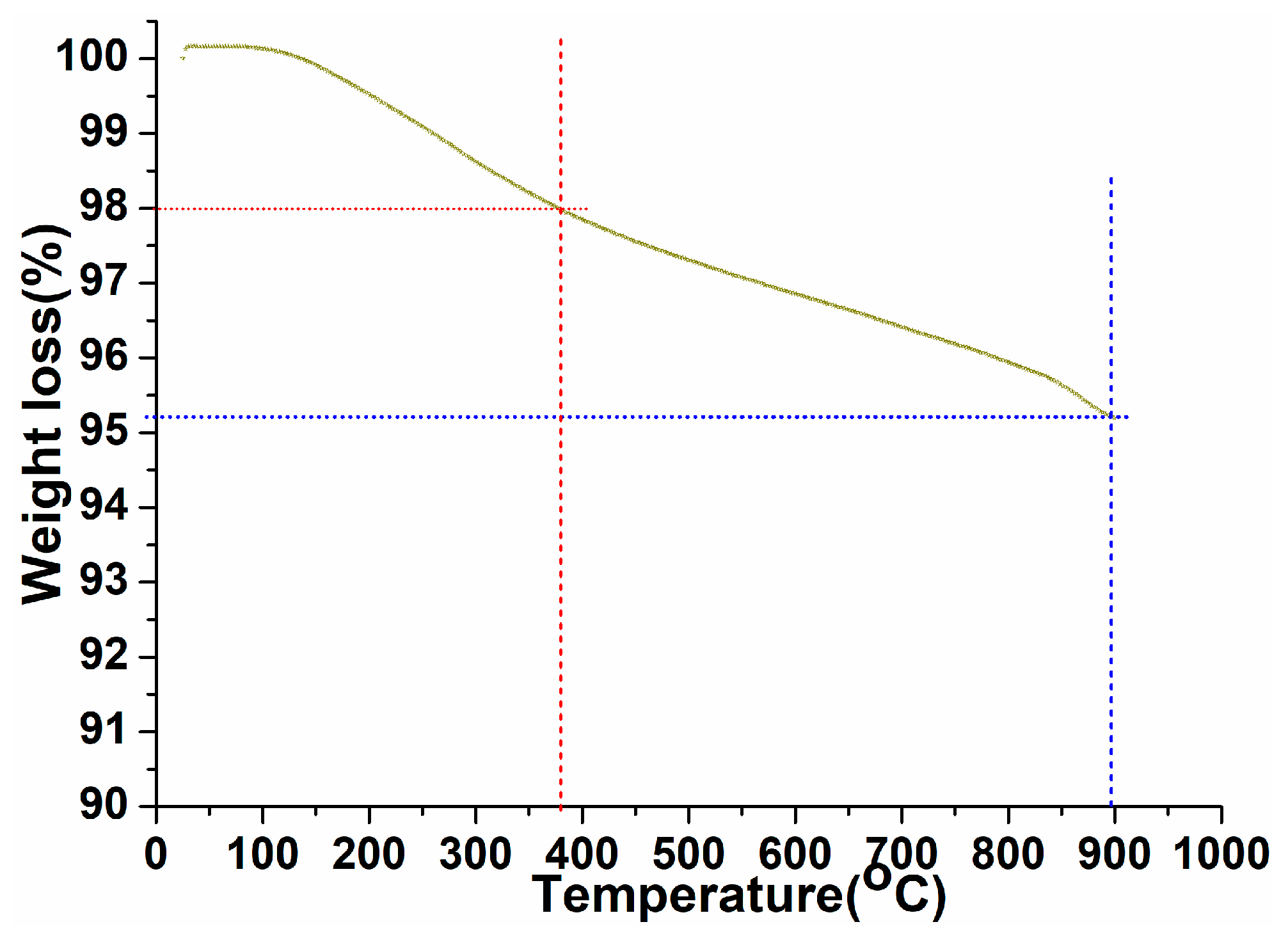

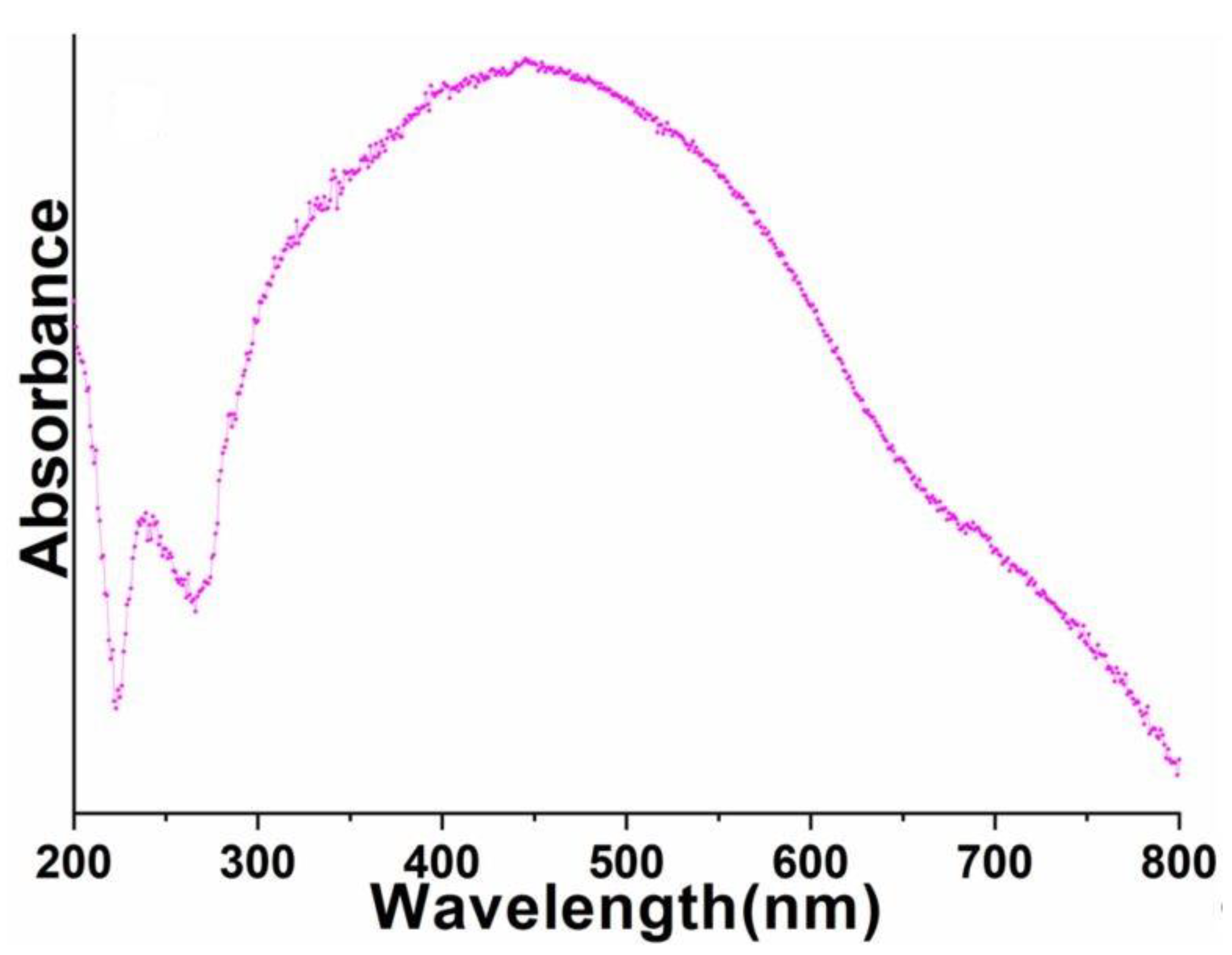

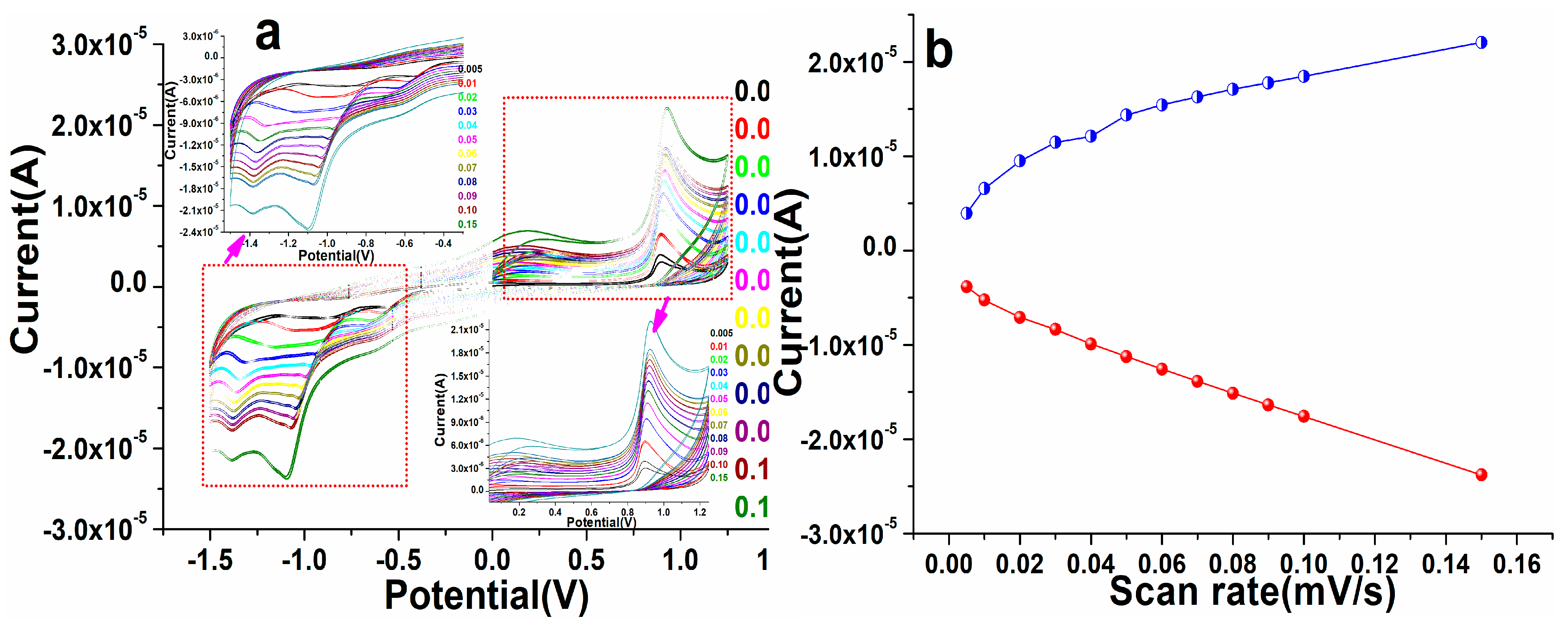
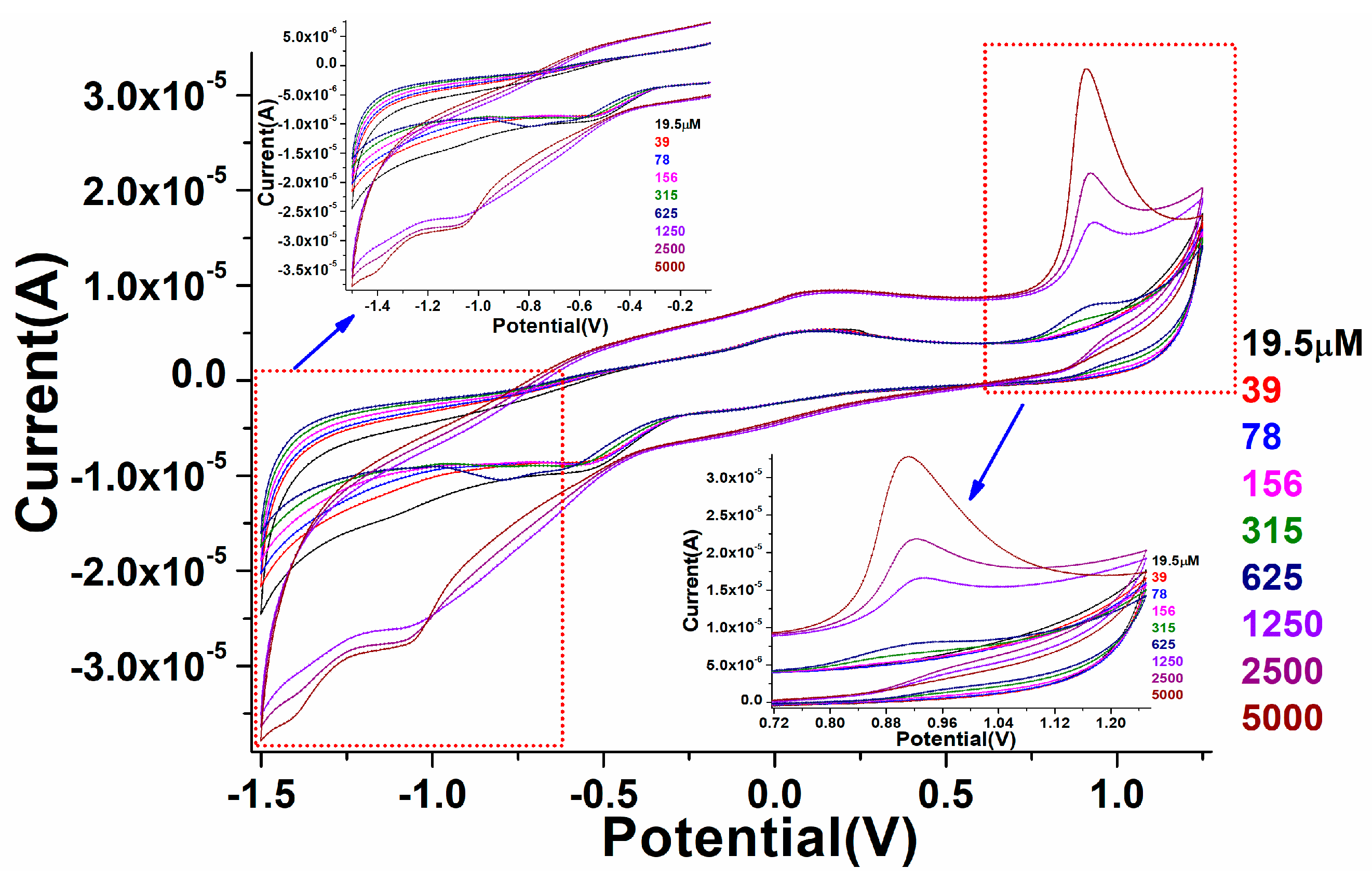

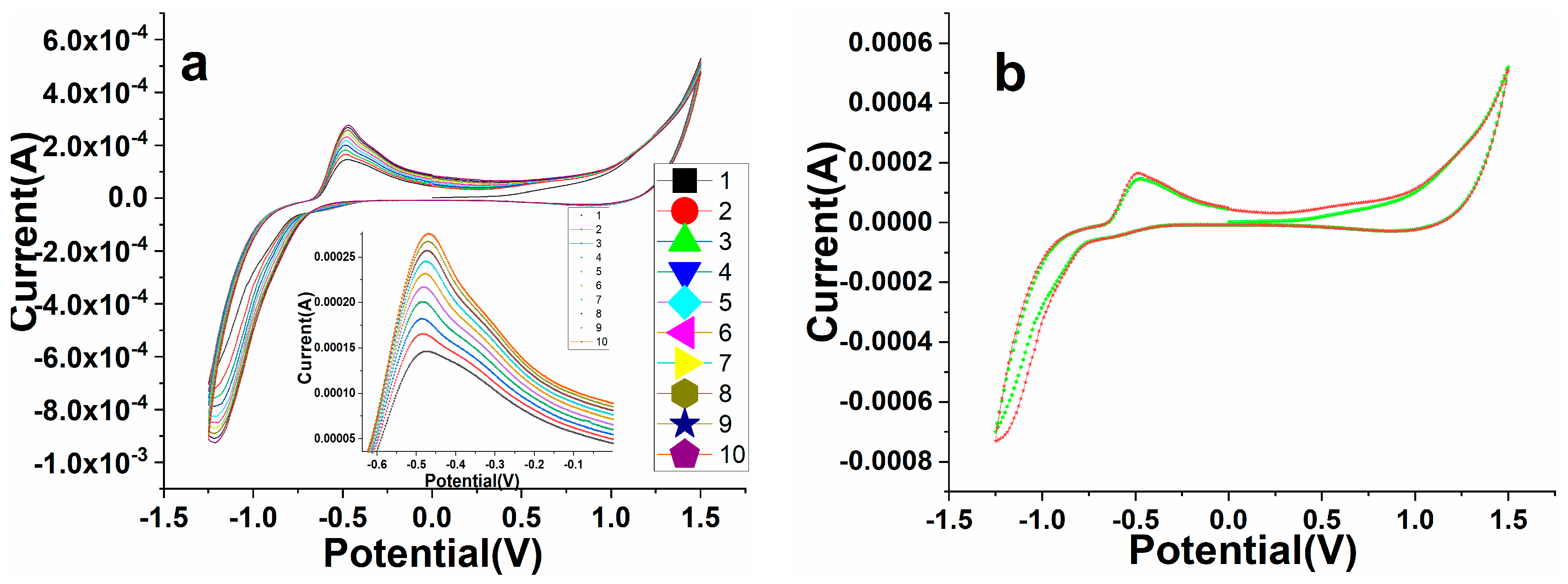


Publisher’s Note: MDPI stays neutral with regard to jurisdictional claims in published maps and institutional affiliations. |
© 2022 by the authors. Licensee MDPI, Basel, Switzerland. This article is an open access article distributed under the terms and conditions of the Creative Commons Attribution (CC BY) license (https://creativecommons.org/licenses/by/4.0/).
Share and Cite
Ansari, A.A.; Alam, M. Perovskite Nanoparticles as an Electrochemical Sensing Platform for Detection of Warfarin. Biosensors 2022, 12, 92. https://doi.org/10.3390/bios12020092
Ansari AA, Alam M. Perovskite Nanoparticles as an Electrochemical Sensing Platform for Detection of Warfarin. Biosensors. 2022; 12(2):92. https://doi.org/10.3390/bios12020092
Chicago/Turabian StyleAnsari, Anees Ahmad, and Manawwer Alam. 2022. "Perovskite Nanoparticles as an Electrochemical Sensing Platform for Detection of Warfarin" Biosensors 12, no. 2: 92. https://doi.org/10.3390/bios12020092
APA StyleAnsari, A. A., & Alam, M. (2022). Perovskite Nanoparticles as an Electrochemical Sensing Platform for Detection of Warfarin. Biosensors, 12(2), 92. https://doi.org/10.3390/bios12020092




